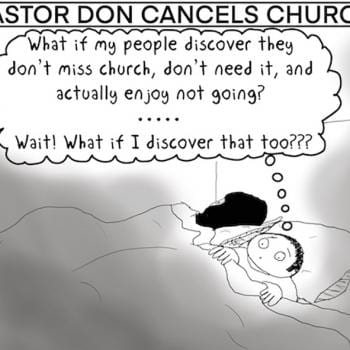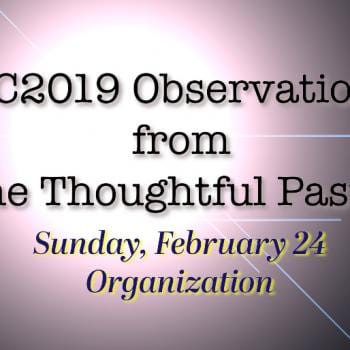We think by operating as a dysfunctional, sick, non-trusting organization, we can turn The United Methodist Church into a functional, life-giving place of hope. Delegates, lacking trust in one another, will make vital decisions on little sleep and a diet of caffeine and sugar. Then we’ll wonder why things went so badly.

“Eight hundred and sixty-four people will sit on the committee.”
When I told my husband, an experienced business owner and currently board chair for two public companies, about the plans for General Conference 2019, his mouth dropped open. Literally. I wish I had thought to have my camera ready.
But yes, that’s the plan. Each of the 864 delegates elected to the specially called 2019 General Conference of The United Methodist Church will sit on the one single committee that has exactly one day to consider all the legislative proposals (I believe the last count was 99) before it. They will then recommend a plan to the General Conference (the same 864 people) that will solve our myriad ills and debates over human sexuality and the nature of our world-wide connection.
And, by the way, everything happening at all times must also be offered in simultaneous translation in these languages: English, French, Portuguese and Kiswahili.
From there, presumably, we move forward with hope and vitality.
The textbook definition of dysfunctional
Yes, this is the textbook definition of a dysfunctional organization.
How did it happen? Because we cannot or will not trust one another.
From the excellent Heather Hahn’s reporting for the United Methodist News Service:
“I think there is a high level of mistrust in the body, and I think this particular approach lessens the mistrust because everybody hears what everybody else hears,” said the Rev. Lynn Hill, a commission member from the Tennessee Conference. In 2016, delegates took three days to debate the rules.
So, of course, my husband’s mouth fell open when I told him the plans. One of his oft-repeated mantras in running businesses: “Trust your committees.” Without that trust, no organization can make substantive decisions. Without believing that the smaller, more nimble, committee structure works competently to discern and distill the best proposals for moving forward, everything stays stuck.
A basic truism: any organization determined to stay dysfunctionally sick insists on serving as a committee of the whole.
A dysfunctional General Conference means bad decisions
I’m hardly a General Conference expert. However, I did attend GC 2016 as a member of the press, writing reports for the United Methodist Reporter and also blogging my way through the craziness of it. I sat in on several legislative committees, watched the debates, noted that while many people came very, very prepared, others did not. Translation problems and differing cultural understandings of the various proceedings made it worse.
Part of the problem is the high level of exhaustion that hits everyone soon. It may not be as bad at this conference since it is shorter. Nonetheless, delegates face long days of mostly sitting and hearing those who love the sounds of their voices at the microphones raising arcane points of order after arcane points of order.
A recent article about Jeff Bezos, founder of the gigantic Amazon shopping enterprise, explained how he manages the many complex decisions before him.
“I go to bed early, I get up early, I like to putter in the morning” reading the newspaper, drinking a cup of coffee and eating breakfast with his children, he said. Mr. Bezos schedules “high IQ” meetings before lunch, and tries to finish making his tough decisions by 5 p.m.
Mr. Bezos said his primary job each day as a senior executive is to make a small number of high-quality decisions. That means getting eight hours of sleep, too. “I think better, I have more energy, my mood’s better,” he said.
If he slept less, he could make more decisions. But it wouldn’t be worth it. “If I have three good decisions a day, that’s enough,” he said. “They should just be as high quality as I can make them.”
Those attending GC 2019 will do exactly the opposite. Delegates will attend early morning strategy sessions, after having stayed up late the night before attending even more strategy sessions. They’ll push as much adrenaline as possible through their systems, delude themselves into thinking they can make vital, high-level decisions on almost no sleep and a diet fueled by caffeine and sugar, and then wonder why things went so badly.
And there is our problem: we think by operating as a dysfunctional, sick, non-trusting organization, we can turn into a functional, life-giving place of hope.
Lessons from a sick pot
I spend much time in my garden, knowing that I learn better life lessons there than any other place. One day last summer, I noted that one of my favorite pots had water sitting on top of the dirt. Thinking it was a temporary problem because of a new watering system I had installed, I removed the mini-sprinkler, put some extra, good quality potting soil in it, and went onto other things.
 It’s not a pot I check often. A few weeks later, however, after some rains but without supplemental water, I saw that the problem had returned and the flowers planted there were dying–their roots had rotted. Concerned, I pulled them out and dug out some of the dirt, hoping for a quick fix.
It’s not a pot I check often. A few weeks later, however, after some rains but without supplemental water, I saw that the problem had returned and the flowers planted there were dying–their roots had rotted. Concerned, I pulled them out and dug out some of the dirt, hoping for a quick fix.
In September, North Texas, where I live, was deluged with rain. After several days of non-stop storms, I checked the pot again and saw at least 18 inches of standing water in it.
No question about it: this pot had gone bad. It happens occasionally: something will plug up the drainage system in the bottom of the pot and everything in it will die from the root up.
There is only one real solution: completely clean out the pot, wash it with disinfectant, let it sit in the sunshine for several days, rebuild the dirt with a better drainage system, and then start over with seeds or transplants.
No big deal with the pot is a reasonable size and weight.
This particular pot, however, is three feet tall and is made of cast iron. It was meant to be planted permanently in its spot in the front yard.
For now, it sits, standing water in the bottom, until a couple of very strong people show up to help me do the work. It still has some stately beauty–but it is not serving its purpose of giving life to plants.
I think that describes pretty closely the state of the UMC. It seems like it should be there forever, held together by good methods and a healthy dose of grace. It’s lasted a long time–surely it can keep going.
Unfortunately, the pot itself, the UMC as a worldwide organization, is putting the local churches in root rot. We’re going to have to clean it out. And it’s going to be very, very difficult.
Are you confused yet? Try reading all the documents.
In a powerful, well researched and amazingly readable piece, scholars and former members of the UMC Judicial Council set out the situation: we are on the verge of a constitutional crisis. The Judicial Council, which functions similarly to the Supreme Court of the United States, rules on the constitutionality of decisions made at General Conferences.
Because of the nature of the documents that control the functioning of The United Methodist Church, much of what delegates vote on at GC 2019 (in the committee of 864 people) will likely provoke some constitutional problem.
Since the publication of this article, the Judicial Council did agree to meet and make some preliminary judgments on the various plans to be presented to GC2019. Normally, these judgments come only after legislation has been proposed and voted on by the General Conference. If you would like to read through the legalese of this recent 58-page decision, click this link: JCD_1366_(Docket_No._1018-12)
And good luck to you. To adequately understand those rulings, you also need to read and absorb the petitions prepared for GC 2019 that delineate the various plans to either keep us together or to punish and/or push out, with as much pain as possible, those who disagree with one another.
Here is the English version of the 93-page report on the petitions. Just in case you would prefer the Kiswahili version, I have linked to it here for your reading pleasure.
Dysfunctional organizations breed confusion
Are you confused yet? Are you tired yet? How up-to-date is your legal training? Can you coherently recite Robert’s Rules of Order so you can present motions, sub-motions, amendments, and procedural delays when things are not going your way? Are you ready to call the question when things are going your way?
Do you have your comments/objections/observations/positions of support or non-support written out in absolutely precise three-minute speeches, not one second more? Will you wear your running shoes so you can race your way to the microphone to stand in line for the usual “Three comments for and three comments against” speaking time?
In case you are a bit rusty about Robert and his rules, let me point you to the short, just 208 pages, online book, originally written in the late 1890’s, for the proper way to conduct public meetings. I’m sure you will find it ever so readable.
Also, if you are a delegate, have you thought about wearing a couple of pair of adult diapers to get through the days of deliberation? After all, you are members of a committee of 864 people, who cannot or will not trust one another, and therefore each may need to speak to every single question. Obviously, there is no time to waste for bathroom breaks . . . or thinking time.
And this procedure will determine the future of The United Methodist Church.
Sigh. Did I mention a sick pot somewhere in this?
Photo credit: another.point.in.time on VisualHunt / CC BY-NC-SA
Photo credit: (c) Christy Thomas













